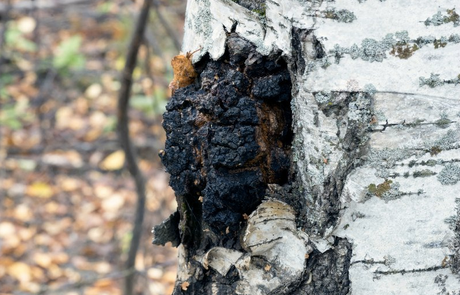Chaga
There is no doubt this indigenous fungi is gaining popularity for its many powerful
virtues. Native to the northern hemisphere, such as Russia, the Canadian Laurentian Plateau, and our very own Appalachian mountains with a wide ranging area from Central New York to Vermont and all the way down to North Carolina. Chaga is generally a birch tree parasitic fungi, although sometimes it occurs on other trees. It’s a fungus that has no stem and looks like burnt wood. It is considered a superfood, rich in vitamins, minerals and antioxidants. Highly valued, in numerous traditional cultures the Chaga mushroom has been considered for many years as a food with miraculous virtues, especially in Japan where it’s known as "the diamond of the forest".
The benefits of Chaga.
Most of the medical research on Chaga has been done in Russia where it grows in abundance as it prefers a cold climate and grows rather slowly. It was found to
modulate the immune system, battle sun damage, relieve pain, complements cancer treatments and protects against radiation. It removes certain parasites, is anti-viral, detoxifies the liver and blood, balances blood sugar, protects the heart, improves circulation, protects the intestine and GI tract, lowers cholesterol, improves cognitive function and memory, increases metabolism and helps with bronchitis. Chaga is an adaptogen which helps to bring the body back to balance. Rich in vitamin B, it also contains vitamin D, flavonoids, phenols, minerals such as copper, calcium, potassium, manganese, zinc, iron and enzymes, Chaga contains one the the highest amounts of antioxidants (25%). Its high content of the enzyme Superoxide Dismutase (an antioxidant) gives it a powerful action against the aging of the body. And like any superfood, it is nontoxic and has no known side effects, nevertheless always consult with your health care provider before taking natural remedies. It is also a source of pantothenic acid (B5), a vitamin essential to the well-being of the adrenal glands and digestive organs. Adaptogens can help us to cope with stress, stay healthy during cold & flu season, and can help us stay focused and avoid depression and adrenal fatigue.
How to consume it.
There are many ways to consume Chaga. The traditional method is to make a
tea or decoction of chunks simmered for 3 to 5 hours, or brewed in a slow cooker over night. The chunks can be stored in the refrigerator and re-used 3-5 times. It is also possible to consume Chaga in powder form and goes well in smoothies, desserts and other foods. You can also consume it in a warm or cold infusion by steeping it for several hours; a method that preserves heat-sensitive enzymes and vitamins. Chaga tea has a rich mellow taste much milder than black tea and can be combined with other more flavorful medicinal teas. Chaga recipes are endless and may be found online. With fall around the corner, Chaga is a good tea or beverage choice to sip by the fire for the cold months on the horizon.
Fall into comfort with Chaga!

